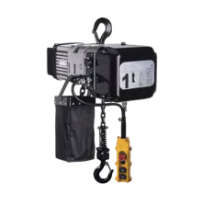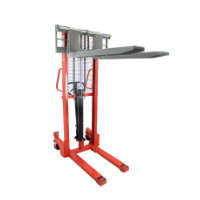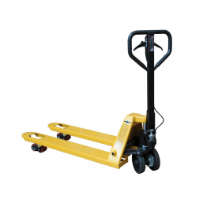Forklifts and Hoists: Complete Buying Guide
Stair-climbing trolleys, pallet trucks, lifts, and hoists are essential tools for transporting and managing goods in the logistics and materials handling sector.
Forklifts are ideal for professional use in warehouses, commercial activities, and moving, as they facilitate the movement of boxes and other bulky objects, reducing physical effort and increasing operational efficiency. For lifting and moving loads at ground level, pallet trucks are particularly useful for warehouse use. For vertical load transportation, lifts, which include scissor lifts, are fixed handling tools designed to lift loads vertically to predetermined heights.
For construction sites, industry, or workshops, hoists are mechanical devices that lift and lower loads via chains or ropes.
This buying guide will provide you with a detailed overview of each machine, helping users make the best choice based on specific needs.
What is and How a Pallet Truck Works
The pallet truck is a two-forked trolley designed to lift and transport pallets. The pallet truck is the basic handling tool for logistics centers, warehouses, workshops, and activities requiring load movement and storage. The lifting of the pallet truck's two forks allows the operator to move heavy loads from point A to point B.
This machine features a traction bar with two main functions: lifting the forks through a pumping action and transporting the load to the desired position. Pallet trucks are commonly available in 2 versions: manual and electric. These models may include a weighing scale. The model choice depends on the type and frequency of handling required.

Types of Pallet Trucks
To correctly choose a pallet truck, you need to evaluate the maximum weight to lift, the type of movement required, and the frequency of load transport. Various types of pallet trucks are available on the market. Here are the main ones:
- Manual Pallet Trucks:
Manual pallet trucks are the simplest and most traditional version of these tools. They work through a traction bar that the operator must pump manually to lift the forks. This type of pallet truck is ideal for lighter loads and small-scale operations. Manual pallet trucks are lightweight, easy to maneuver, and require no power source, making them an economical choice. - Manual Pallet Truck with Scale:
Manual pallet trucks with integrated scales allow weighing loads in real time. These tools feature load cells and a display showing the weight of the lifted load. This function is particularly useful in warehouses and distribution centers where verifying merchandise weight during handling is necessary. - Electric Pallet Truck:
Electric pallet trucks feature battery-powered motors that facilitate both lifting and load movement. These models significantly reduce the physical effort required by the operator and increase operational efficiency, making them ideal for frequent use and heavy load transport. Electric pallet trucks are available in various configurations, including compact versions for tight spaces and robust models for industrial environments. - Electric Pallet Truck with Scale:
Electric pallet trucks with scales offer the advantages of electric models combined with the ability to weigh loads during movement. They feature an integrated weighing system, and electric motorization makes them ideal for frequent load movements. Like manual pallet trucks with scales, they feature load cells and a display to read merchandise weight.

What is and How a Stair-Climbing Trolley Works
A stair-climbing trolley is a tool designed to facilitate the transport of heavy loads up and down stairs. The stair-climbing trolley consists of a robust metal structure, specially configured wheels, and in some models, an electric motor. The wheels are often arranged in a three-wheel system or star configuration that allows the trolley to "walk" on steps. The operator places the load on the trolley and uses handles to guide it up and down stairs. In manual models, the operator must forcefully push the trolley to lift it on each step, while in motorized models, the motor significantly reduces the required effort, allowing movement of heavier loads.
Stair-Climbing Trolley Variants
Beyond the stair-climbing trolley described above, there are some subtypes designed for different uses:
- Platform Truck:
The platform truck is a simple device used to transport bulky and heavy loads on flat surfaces. It's commonly used in offices, shops, warehouses, and during moves. It consists of a wheeled platform and a handle to push or pull the load. The platform is generally made of sturdy metal or hard plastic, capable of supporting considerable weights. The wheels, often rubberized, allow easy movement even on uneven surfaces. To use the platform truck, the operator loads objects onto the platform and pushes or pulls them to the desired position. - Milk Crate Trolley:
A milk crate trolley is specifically designed for transporting milk crates or bottles. It consists of a sturdy metal structure with large, robust wheels. Its particularity is that it features racks or specific supports designed to ensure milk crate stability during transport.
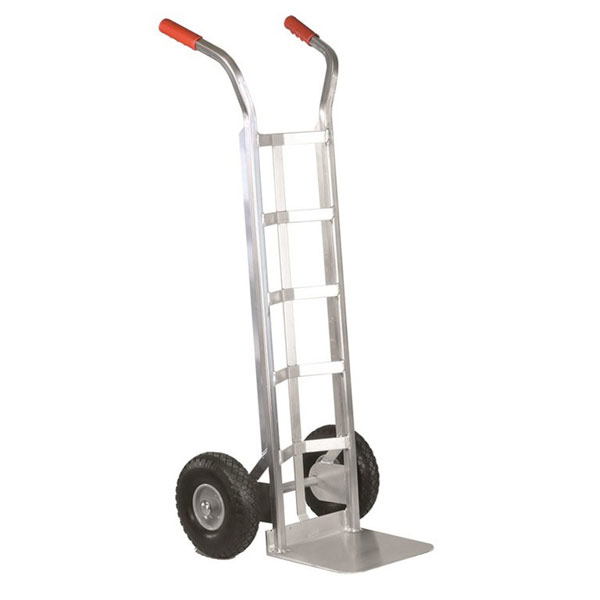
What is and How a Hoist Works
A hoist is a mechanical device used to lift and move heavy loads. There are various types of hoists, including manual, electric, and pneumatic, each designed for specific applications. A hoist's operating principle is based on using pulleys, cables, or chains to multiply the applied force, allowing loads to be lifted with relatively little effort.
Hoists are essential for lifting heavy materials in garages, workshops, construction sites, factories, ports, warehouses, and industry. Using a hoist facilitates heavy goods transport operations, but strict safety procedures must always be followed for correct use.
Types of Hoists
To correctly choose a hoist, you must consider the maximum load to lift, the desired lifting speed, and whether you need a manual or electric hoist.
- Manual Chain Hoist:
The manual hoist is hand-operated, generally via a chain that the operator pulls to lift the load. A chain hoist uses a chain that passes over two pulleys mounted on the same shaft, with wheels of different diameters. When the chain is pulled, the wheels rotate counterclockwise, and the larger wheel amplifies the force, reducing the effort needed to lift the load. Hooks attach the load and suspension point. Pulling the chain one way lifts the load; pulling it the other way lowers the load. This system allows lifting heavy loads with less effort thanks to force multiplication. The manual chain hoist is simple, economical, and requires no external power source, making it ideal for occasional operations. Compared to electric models, it requires more time and operator effort. A manual hoist's maximum load is around 6 tons. - Electric Hoist:
It operates on the same principle as a manual hoist, but the operator's push is replaced by an electric motor. This device features a control panel. Some electric models include a pulley that multiplies the force applied by the motor, allowing direction changes and facilitating lifting in tight spaces. Electric hoists are ideal for regularly lifting heavy loads, thanks to their ability to handle greater weights than manual hoists. Additionally, they feature a lifting and lowering speed control system that allows moving loads slowly and precisely. Electric hoists are used in construction and are useful for industry, logistics, and workshops. An electric hoist's maximum load is around 10 tons. For heavy industry electric hoists, the maximum load reaches 20 tons.

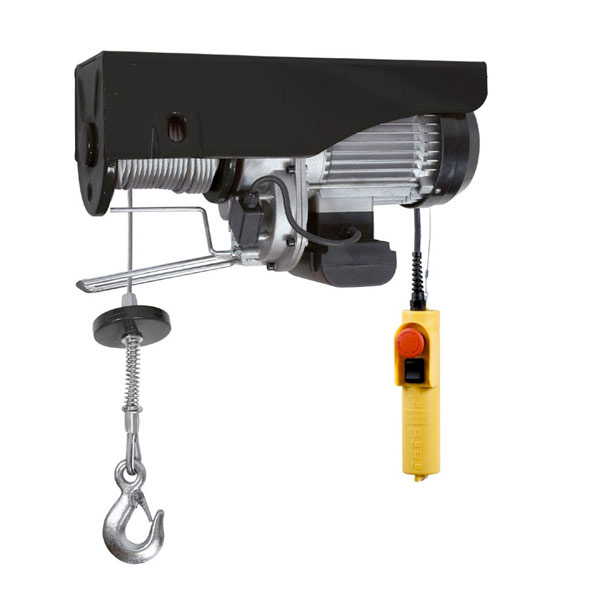
What is and How a Lift Works
A lift is machinery used to efficiently and safely lift, lower, and move heavy or bulky loads. Lifts are employed in various sectors including construction, industry, logistics, and maintenance. A lift's operation involves transferring the applied force (manual, hydraulic, or electric) to lift a load from rest position to an elevated position. Designed to ensure stability and safety during use, lifts minimize the physical effort required by operators to lift loads. There are different types of lifts, each designed for specific applications and operating modes.
Types of Lifts
There are various types of lifts, ideal for moving loads according to needs:
- Scissor Lift:
The scissor lift uses a scissor mechanism consisting of crossed arms that extend and contract, raising or lowering the platform. When force is applied, for example via a hydraulic cylinder, the arms push against each other, lifting the platform steadily and controllably. This type of lift is commonly used in workshops, warehouses, and production lines for loading and unloading operations. - Manual Lift:
The manual lift has a telescopic structure mounted on a wheeled trolley. Along the vertical rod slide two forks where the load to be lifted is placed. The up and down movement is manually operated via a crank winch. The operator uses the crank to lift the load slowly and precisely. These lifts are ideal for lifting light or medium loads and are perfect for small businesses, laboratories, and workshops. - Electric Lift: The electric lift is motorized and uses a battery-powered electric motor to lift and lower heavy loads. This type of lift is very efficient and can be operated via a button or remote control. It's ideal for industrial applications requiring frequent lifting of heavy loads quickly and precisely. Electric lifts can be fixed or mobile and often feature advanced functions like lift speed control that improve safety and operational efficiency.

Choosing the right stair-climbing trolley, pallet truck, lift, or hoist may seem difficult, but with support from Indors' expert team it becomes simple. We'll help you find the perfect model for your needs, considering the work environment, frequency of use, and load types. Contact us for questions or personalized advice. Our expert team is ready to provide all necessary information to ensure optimal choice, improving efficiency and safety.


